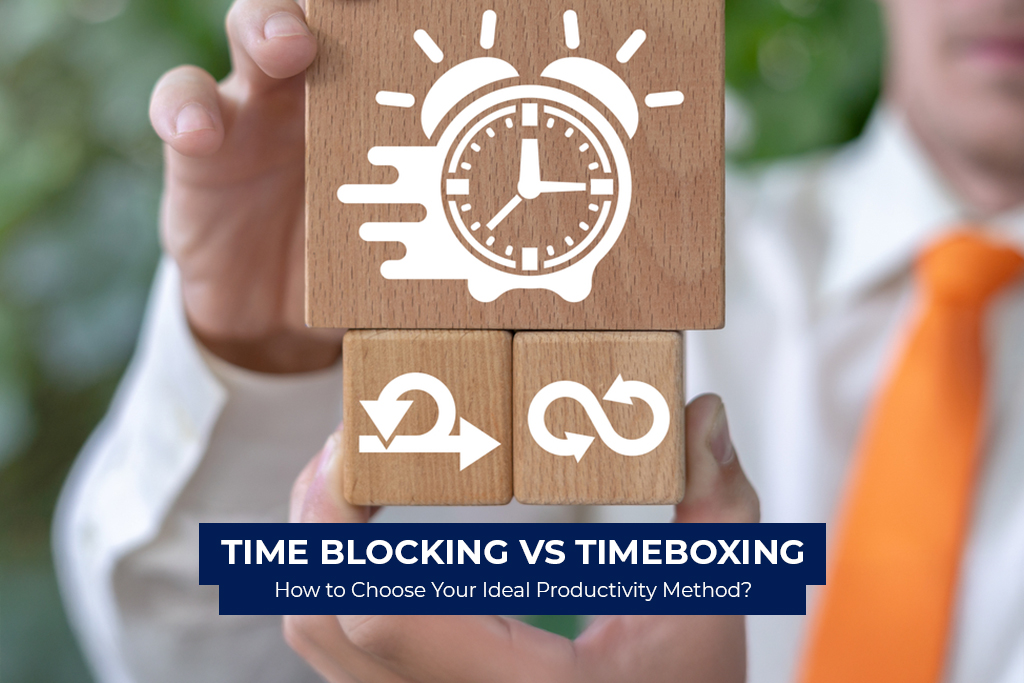Time Blocking vs Timeboxing: How to Choose Your Ideal Productivity Method?
Table of Contents
Are emails, meetings, and work commitments taking over your work day, having a direct impact on your productivity? You need time management techniques that can help you control your schedule, thus making time for tasks that matter the most.
Two of the more popular time management techniques are Time blocking and Timeboxing. Time blocking and timeboxing, both, work by breaking up your schedule into smaller, manageable chunks, allowing you to focus on one task at a time. This might make them sound similar, but there’s a difference. This is how they work, at a glance:
Time blocking takes into account your entire day and assigns blocks of time to different activities.
Timeboxing encourages you to tackle specific tasks within a set, allocated time.
While both methods are designed to help you take back control of your working day, they both employ a wholly different approach. Before you choose which one works best for you, let’s understand how the two techniques work.
What is Time Blocking?
In this time management technique, you create a daily structured schedule and set aside dedicated time for particular tasks. These time blocks are non-negotiable and allow you to focus on your important tasks without interruptions. This is a great way to understand how you spend your time at work. As you realize how long it takes to complete tasks, you will notice better accuracy in planning your days.
Benefits of Time Blocking
Enhanced Prioritization
Time blocking focuses on prioritizing tasks as per importance, allowing you to allocate specific periods for the most critical tasks of the day. This helps you make clearer, faster decisions about what task to focus on.
Better Focus and Minimal Multitasking
Multitasking is a myth. When you schedule and block time for specific jobs, it is easier to focus on and complete a single task instead of inefficiently juggling multiple activities. By dedicating a fixed block of time to a specific task, you can work without interruptions, improving your productivity.
Better Work-Life Balance
Time blocking works well in your personal life, too. When you set aside time for personal activities, it creates space for downtime and allows you to come back to work refreshed. This helps avoid overcommitting, reduces stress, and prevents burnout.
What is Timeboxing?
This method takes a slightly different approach. Instead of adjusting time around tasks, this method sets a time limit for a particular task. One of the biggest advantages of timeboxing is that it pushes you to work more efficiently. Knowing there is limited time to complete a task will make you more productive.
Benefits of Timeboxing
Improved Focus and Efficiency
Timeboxing helps create a sense of urgency and gives you a deadline to work against. This helps you concentrate on a single task without losing focus. Instead of switching between tasks and not accomplishing anything, dedicated time slots give you a goal to focus on.
Less Procrastination
Everyone procrastinates, to varying degrees. When you decide beforehand to break up your day into structured time slots, it makes it easier to start, even some of the challenging projects. The non-negotiable builds urgency and reduces the tendency to procrastinate, keeping you accountable. You can even break up overwhelming tasks into smaller, manageable timeboxes with achievable deadlines.
Better Task Estimation
When you apply timeboxing techniques regularly, it hones your ability to estimate how long a particular task will take. In the beginning, you might notice you’re giving more time to some tasks and not enough to others. With practice and regular implementation, you’ll achieve greater productivity levels.
Time Blocking versus Timeboxing – Which is the Right Method for You?
Choosing between time blocking and timeboxing depends on multiple factors, such as individual productivity style, tasks at hand, long-term goals, and even your energy levels throughout the day. Both methods have unique benefits, so it is important to know how to choose between them to improve productivity.
Understand Your Workflow
How do you get work done? If you are someone who prefers a structured day, with all tasks planned, then time blocking might be better for you. This takes away the stress of decision-making when you already know what task to take on after completing one. However, timeboxing is suited for tasks that require a strict limit. Unfortunately, if your role is creative, this method may not work for you.
Study Your Energy Patterns
Are you a morning person, or does your energy go through ups and downs throughout the day? In the case of the former, time blocking helps because you can focus on the most demanding tasks during peak energy hours. Timeboxing helps you adapt to varying energy levels, where you work with manageable time chunks.
Experiment and Adapt
The best way to identify the correct time management method is by trying both. Begin by using the time blocking technique to create a structured day. Within that, use timeboxing for tasks that need extra focus. Here’s one way to do it. Block two hours for creative work and then break it down into several timeboxes for steady progress. Yes, the two methods rely on rigidity but don’t be too hard on yourself. Make changes as you progress until you find the approach that works best for you.
Use Tools to Enhance Time Management
Time management becomes much easier when you turn to the right software. The market has several tried-and-tested tools, such as Google Calendar, Trello, etc., that can help improve focus, reduce procrastination, and increase productivity.
Take Control of Your Time
Remember, there is no right or one approach to time management. Neither time blocking nor timeboxing is better than the other. People work differently, and their responsibilities and goals are different.
An easy way to understand which method suits you better is to block out time for specific tasks throughout the day, and then divide those blocks into smaller time boxes. This allows you to get the most out of both systems. Start small and make changes based on what works for you.






